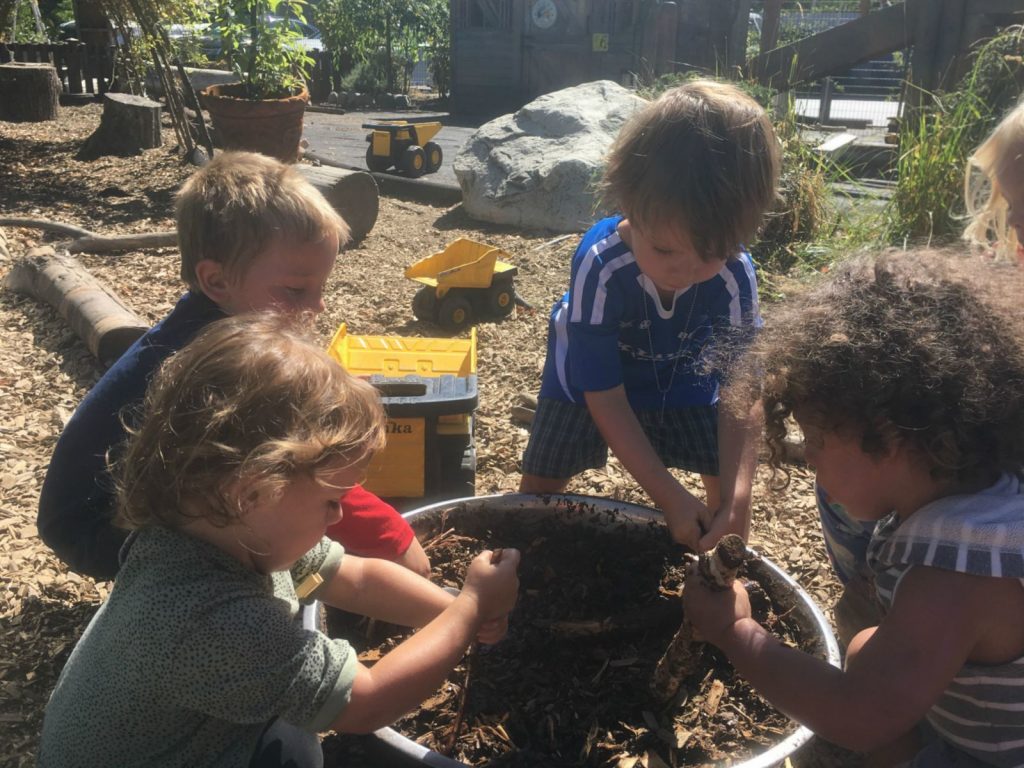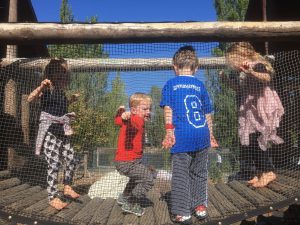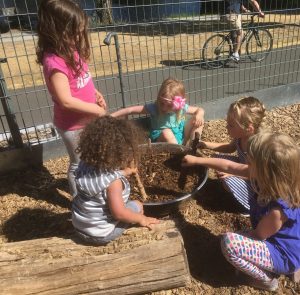
Fostering Inclusion in the Classroom
I am constantly amazed and impressed by the group of kiddos I have in my class. When the school year began back in September, my co-teachers and I immediately noticed how quickly the children began connecting to one another and how strong their desire was to create a sense of community with peers and teachers. Over the next seven months, we watched friendships blossom between children, and we also observed those relationships change and grow between a social, friendly group of preschoolers. As expected, there were bumps along the path to developing empathy, building relationships, and strengthening social skills. In this post, I’ll explore some of the ways we can support children on this path. But first, some questions to help deepen our thinking and understanding around inclusion, advocacy and relationship building.
- How do we foster inclusion and help children experience more success in their peer relationships?
- Why do children feel compelled to exclude others from their play?
- What are some of the underlying reasons this happens?
- What can a child do when the answer to their request to join a game is “No”?
- What type of language do we use to address instances of exclusion when they arise?
It can be helpful to remember that sometimes children say “no” when peers want to join their play simply because, developmentally, they are not yet confident navigating play with more than one peer. These children may still be working on being successful in one-on-one interactions and may not yet have the tools needed to handle the additional complexity of adding a third or fourth playmate. By this point in the year (November), many kids have had a great deal of practice playing with larger groups of children and managing games with more than one other child. However, this is still an area of growth for some kids, so we take this into consideration when a child excludes a peer. If we see that this is a challenge for a child, one of the ways we can offer support is by modeling appropriate social behavior like taking turns, listening to others’ ideas and acknowledging them verbally or with eye contact and body language, like nodding or smiling.
 Of course, there are other times when kids say “no” to peers who want to join their play because they are just beginning to understand and explore the power they wield in these social situations. I’ve found that the best approach in these instances is a multifaceted one:
Of course, there are other times when kids say “no” to peers who want to join their play because they are just beginning to understand and explore the power they wield in these social situations. I’ve found that the best approach in these instances is a multifaceted one:
First, we can work with the child who is feeling excluded to help them reclaim some of that lost power and create balance in their peer relationships. We can encourage the child who is being told they can’t play to ask “Why not?” and pursue a solution. Another way to do this is to offer alternative language that can be used as children attempt to enter games. Instead of asking, “Can I play?”, they can say, “How can I play?” or, “I want to play. What can I be in this game?” This negates some of the power dynamic at work and invites the other child to look for a solution (i.e. finding a way to create space in the game for their peer) instead of trying to exclude or be “in charge” of the game. Children can also advocate for themselves by seeking out other peers to play with if they do not feel like they are being treated fairly in a game. Again, this takes the power of out the power struggle and often, the child who was excluding realizes it would be more fun to play with their peers than to try to control the game or characters. The more that we support children in exploring solutions and coming up with new ones, the more confident, capable and skilled they become in their roles as problem-solvers.
In these power play situations, we also work with the child who is excluding to find out why they are taking this approach:
- Are they feeling powerless in another area of their life?
- Are they angry with the peer for a past slight that is not forgotten?
Often, young children feel powerless in a world full of powerful adults, and they may try to exert whatever power they feel they have, be it with toilet training, eating, sleeping or in this case, excluding peers from play. In these instances, it can be helpful to look for ways to allow for autonomy and control in more appropriate and rewarding ways. This should usually be done with support from the family, as a child’s time at home strongly shapes their experience at school. In addition, we work with the child or children to find ways to express their feelings and work through conflict with peers. Through our observations, our knowledge of these children, and the questions we ask them, we become able to delve deeper into the underlying reasons for the exclusion, and come up with strategies for more successful interactions.
Fostering inclusion is not as simple as telling the kids that everyone gets to play. While this is the overarching agreement in Beach room, as well as the rest of Hilltop, there are several factors we consider, and ask the kids to consider, when they are trying to enter a game:
- Is the game already underway and action-packed? Sometimes, when the children are involved in an intense game of good guys/bad guys, princesses and kitties or any other game that has them running around, hiding, chasing and capturing each other, stopping everything so one child can ask if he or she can play isn’t usually realistic. Doing so can interrupt the trajectory of a game that may have already taken significant effort, time, negotiation, compromise and perspective taking. It can garner a frustrated response from the children who were forced to stop in the middle of their great escape or mad pursuit.
- We let kids know that sometimes it’s okay to just join the game without stopping for a big conversation. The kids are beginning to understand the idea of entering a game that’s already begun and just creating a role for themselves. This is a process that involves observing, finding a role/character, announcing it and jumping into the action. Learning when this is appropriate can be tricky, so we look for ways to help kids make that distinction by providing our observations and helping them interpret what they see going on to better understand non-verbal cues, both receptively and expressively, and then letting them decide if they want to join. For example, if a child wants to join a game of chase and is having a hard time getting the attention of one of the children involved in the game, our conversation with that child might begin like this:
“Those kids are running around and I hear them saying, ’Let’s get those kitties!’ They are really focused on the game. But I noticed that Opal just joined the game and started meowing, so they knew she was a kitty who wanted to be chased.”
- In some situations, children will say, “I’m not playing with you,” in the middle of a game as a way to avoid being caught or captured, or when the game starts getting bigger than they anticipated. In these situations, we find that encouraging more specific language helps everyone get on the same page. Children learn to change the message from “I’m not playing with you,” to “That’s too rough,” or “It’s scary and I need a break.” Also, if appropriate, we can work with the kids to create agreements around their game so everyone understands the expectations and feels safe and welcome.
- In addition to in-the-moment support, modeling, and revisiting situations through conversations with the kids, we can also use social storytelling, Teacher Theater and group discussions/Q&A to help children come up with ways to advocate for themselves, independently engage in social problem-solving and successfully connect with their peers. In the past, a co-teacher and I have put on Teacher Theater performances for kids where we acted out several different social scenarios, each of which highlighted the various types of exclusion that we saw happening in our classroom. After each “act,” we would “end scene” and talk with the kids about what they noticed in the scenario and ask them to think about ways to solve the problems that were played out before them. This proved to be a great way to deepen the conversation around inclusiveness and friendship and allowed the children to solve the social problems they saw occurring. Additionally, children begin to feel empowered in their roles as advocates, for themselves and others, and as skilled problem-solvers.
The idea of inclusion is not one that can be relegated to just the classroom, rather it is a matter that is of critical importance to our society. Without inclusion, we create the conditions for divisiveness, a dwindling supply of empathy, and a lack of understanding and acceptance of others. For this reason, we view the work of fostering inclusion in the classroom as one of the most important elements of our work with children and families. A classroom where inclusiveness thrives is one where each child feels valued, cared for, free to explore, and empowered to get up to the most important work of all, learning through relationships and play.
Increasingly, Inclusion and Inclusive Education are becoming buzzwords to which everyone subscribes. However, behind the language lies a struggle for human rights, which is by no means won nor complete.
- Every child has a fundamental right to education and must be given the opportunity to achieve and maintain acceptable levels of learning.
- Every child has unique characteristics, interests, abilities and learning needs.
- Education systems should be designed and educational programmes implemented to take into account the wide diversity of these characteristics and needs.Promoting inclusion within mainstream schools, where parents want it and appropriate support can be provided will remain the cornerstone of our strategy
- This is an important part of building an inclusive society
Inclusion, Diversity, and the Opportunity and Achievement Gap are buzzwords to which everyone subscribes to. However, behind the language lies a struggle for human rights. While every child has the right to participate in a community regardless of one’s identify, status or belief, we often use our power as adults over children in oppressive ways. On December 8th, we actively discuss and seek ways Seattle and the entire Pacific Northwest can better listen to and represent children, in order to enact change that the city and the world needs to see. Facilitated by co-creator of the film, John Nimmo, this documentary and dialogue will examine ways we can implement children’s rights within our own communities to create a more just society. Together, we’ll stop ignoring our most vulnerable citizens, and start paying attention to the Voices of Children. Spaces are limited. Register now to avoid missing out. Visit https://hilltopcc.com/film
Shalla is an educator with 2- to 5-year-olds at Hilltop Children’s Center, where she has worked since 2011.
2 thoughts on “Fostering Inclusion in the Classroom”
Comments are closed.


Wow. Thank you for putting into words so many of the concepts and philosophies I hold in my heart and head around this type of work! It’s hard work, indeed, and takes careful coaching most of the time; I also loved how you highlighted the ways that, sometimes, it doesn’t have to be so careful or exact — “Try meowing!” could be the helpful cue! 🙂 I’m grateful that you list both the possible reasoning behind the children’s actions you observed as well as the different ways you could respond to the needs you perceived. Thank you for this thoughtful piece. Much to ponder and share!